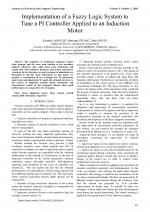| 3/2009 - 19 | View TOC | « Previous Article | Next Article » |
Implementation of a Fuzzy Logic System to Tune a PI Controller Applied to an Induction MotorLAROUSSI, K. |
| Extra paper information in |
| Click to see author's profile in |
| Download PDF |
Author keywords
induction motor, fuzzy control, hybrid control, field orientation, supervisor
References keywords
fuzzy(8), control(8), floue(5), systems(4), logique(4), controller(4), commande(4)
Blue keywords are present in both the references section and the paper title.
About this article
Date of Publication: 2009-10-26
Volume 9, Issue 3, Year 2009, On page(s): 107 - 113
ISSN: 1582-7445, e-ISSN: 1844-7600
Digital Object Identifier: 10.4316/AECE.2009.03019
Web of Science Accession Number: 000271872000019
SCOPUS ID: 77954747548
Abstract
The simplicity of traditional regulators makes them popular and the most used solution in the nowadays industry. However, they suffer from some limitations and cannot deal with nonlinear dynamics and system parameters variation. In the literature, several strategies of adaptation are developed to alleviate these limitations. In this paper, we propose a combination of two strategies for PI parameters supervision and adaptation. We apply the obtained structure to the control of induction machine speed. Simulation and experimental results of the proposed schema show good performances as compared to two strategies. |
| References | | | Cited By «-- Click to see who has cited this paper |
| [1] K. Laroussi, M. Zelmat, "Commande par logique floue d'un moteur a induction", SNCS'2001 Octobre Djelfa, Algeria
[2] Sicking, J.P. and Sillevis Smith, W.W. and van Nauta Lemke, H.R., "A design of a fuzzy supervisor for systems with a PID controller" [3] Litt, J., "An expert system to perform on-line controller tuning", IEEE Control System, 1991, April, pp. 18-23 [CrossRef] [SCOPUS Times Cited 27] [4] S. Saetieo, D. A. Torrey, "Fuzzy Logic control of a space vector PWM current regulator for three phase power converters", IEEE Trans. On Power Electronics, Vol.13, No.3, PP.419-426, May, 1998 [CrossRef] [5] Sicking, J.P. and Sillevis Smith, W.W. and van Nauta Lemke, H.R., "A design of a fuzzy supervisor for systems with a PID controller" [6] Van Nauta Lemke, "Design of fuzzy control systems", jornee de commande floue, 1991, Paris France [7] L. Baghli, "Contribution a la commande de la machine asynchrone, utilisation de la logique floue, des reseaux de neurones et des algorithmes genetiques", These de Doctorat. 1999, Nancy, France Sous la Direction de M. J. Faucher. [8] B. Chetate, A. Khaldoun, "Commande Indirecte a Flux Rotorique Oriente d'une Machine a Induction avec Adaptation de la Constante de Temps Rotorique par Logique Floue", First International Conference on Electrical Engineering, ICEE'2000 [9] H. Bhuler, "Reglage par logique floue", Presse Polytechnique et Universitaire Romandes, Lausane, 1994 [10] S. I. Smedley, "The Interpretation of Ionic Conductivity in Liquids", Plenum Press, 1980 [PermaLink] [11] Babusta, R. And Horacek, P., "Laboratory Evaluation of fuzzy controllers", in the PREPRINTS of the IFAC/IFIP/IMACS International Symposium on artificial in real-time control, 1992, June 16-18 Delft, the Netherlands pp. 263-268 [CrossRef] [12] Oliveira, P. And Lima, P. And Sentieiro, "Fuzzy supervision on intelligent control systems", European control conference, 1991, July 2-5, Grenoble, France, pp. 1226-1231 [13] Tzafestas, S. and Papanikolopoulos, N., "International Fuzzy expert PID control", IEEE transaction on industrial electronics, 1990, vol. 37, No. 5, October, pp. 365-371 [CrossRef] [Web of Science Times Cited 144] [SCOPUS Times Cited 203] [14] A. Hazzab, I. K. Bousserhane, M. Zeebo and P. Pascard, "Real time implantation of fuzzy gain scheduling of PI controller for induction motor machine control", Neural Processing Letterers (2006) pp, 24:203-215, Springer [CrossRef] [Web of Science Times Cited 25] [SCOPUS Times Cited 37] Web of Science® Citations for all references: 169 TCR SCOPUS® Citations for all references: 267 TCR Web of Science® Average Citations per reference: 12 ACR SCOPUS® Average Citations per reference: 19 ACR TCR = Total Citations for References / ACR = Average Citations per Reference We introduced in 2010 - for the first time in scientific publishing, the term "References Weight", as a quantitative indication of the quality ... Read more Citations for references updated on 2025-06-03 01:53 in 36 seconds. Note1: Web of Science® is a registered trademark of Clarivate Analytics. Note2: SCOPUS® is a registered trademark of Elsevier B.V. Disclaimer: All queries to the respective databases were made by using the DOI record of every reference (where available). Due to technical problems beyond our control, the information is not always accurate. Please use the CrossRef link to visit the respective publisher site. |
Faculty of Electrical Engineering and Computer Science
Stefan cel Mare University of Suceava, Romania
All rights reserved: Advances in Electrical and Computer Engineering is a registered trademark of the Stefan cel Mare University of Suceava. No part of this publication may be reproduced, stored in a retrieval system, photocopied, recorded or archived, without the written permission from the Editor. When authors submit their papers for publication, they agree that the copyright for their article be transferred to the Faculty of Electrical Engineering and Computer Science, Stefan cel Mare University of Suceava, Romania, if and only if the articles are accepted for publication. The copyright covers the exclusive rights to reproduce and distribute the article, including reprints and translations.
Permission for other use: The copyright owner's consent does not extend to copying for general distribution, for promotion, for creating new works, or for resale. Specific written permission must be obtained from the Editor for such copying. Direct linking to files hosted on this website is strictly prohibited.
Disclaimer: Whilst every effort is made by the publishers and editorial board to see that no inaccurate or misleading data, opinions or statements appear in this journal, they wish to make it clear that all information and opinions formulated in the articles, as well as linguistic accuracy, are the sole responsibility of the author.



